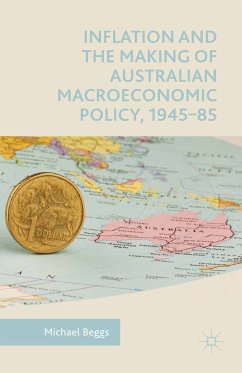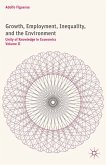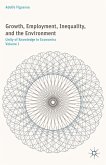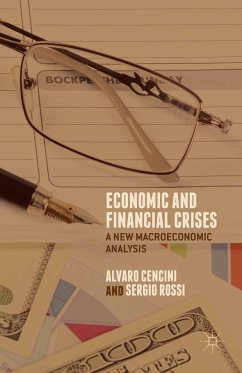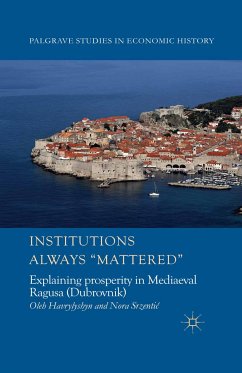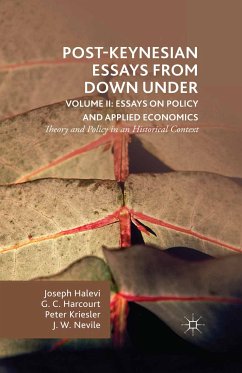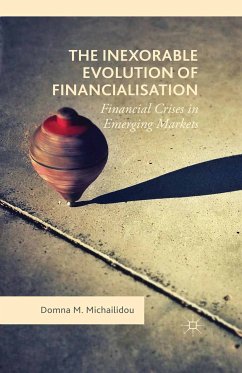Michael Beggs
Inflation and the Making of Australian Macroeconomic Policy, 1945-85 (eBook, PDF)
73,95 €
73,95 €
inkl. MwSt.
Sofort per Download lieferbar

37 °P sammeln
73,95 €
Als Download kaufen

73,95 €
inkl. MwSt.
Sofort per Download lieferbar

37 °P sammeln
Jetzt verschenken
Alle Infos zum eBook verschenken
73,95 €
inkl. MwSt.
Sofort per Download lieferbar
Alle Infos zum eBook verschenken

37 °P sammeln
Michael Beggs
Inflation and the Making of Australian Macroeconomic Policy, 1945-85 (eBook, PDF)
- Format: PDF
- Merkliste
- Auf die Merkliste
- Bewerten Bewerten
- Teilen
- Produkt teilen
- Produkterinnerung
- Produkterinnerung

Bitte loggen Sie sich zunächst in Ihr Kundenkonto ein oder registrieren Sie sich bei
bücher.de, um das eBook-Abo tolino select nutzen zu können.
Hier können Sie sich einloggen
Hier können Sie sich einloggen
Sie sind bereits eingeloggt. Klicken Sie auf 2. tolino select Abo, um fortzufahren.

Bitte loggen Sie sich zunächst in Ihr Kundenkonto ein oder registrieren Sie sich bei bücher.de, um das eBook-Abo tolino select nutzen zu können.
In the decades after World War II, inflation undermined the aspiration for full employment in Australia. This book tells the story of how the Australian state was shaped by the confrontation with monetary instability: a pre-history of neoliberalism.
- Geräte: PC
- ohne Kopierschutz
- eBook Hilfe
- Größe: 4.14MB
Andere Kunden interessierten sich auch für
![Growth, Employment, Inequality, and the Environment (eBook, PDF) Growth, Employment, Inequality, and the Environment (eBook, PDF)]() A. FigueroaGrowth, Employment, Inequality, and the Environment (eBook, PDF)73,95 €
A. FigueroaGrowth, Employment, Inequality, and the Environment (eBook, PDF)73,95 €![Endogenous Growth, Market Failures and Economic Policy (eBook, PDF) Endogenous Growth, Market Failures and Economic Policy (eBook, PDF)]() Martin ZaglerEndogenous Growth, Market Failures and Economic Policy (eBook, PDF)73,95 €
Martin ZaglerEndogenous Growth, Market Failures and Economic Policy (eBook, PDF)73,95 €![Growth, Employment, Inequality, and the Environment (eBook, PDF) Growth, Employment, Inequality, and the Environment (eBook, PDF)]() A. FigueroaGrowth, Employment, Inequality, and the Environment (eBook, PDF)73,95 €
A. FigueroaGrowth, Employment, Inequality, and the Environment (eBook, PDF)73,95 €![Economic and Financial Crises (eBook, PDF) Economic and Financial Crises (eBook, PDF)]() A. CenciniEconomic and Financial Crises (eBook, PDF)89,95 €
A. CenciniEconomic and Financial Crises (eBook, PDF)89,95 €![Institutions Always 'Mattered' (eBook, PDF) Institutions Always 'Mattered' (eBook, PDF)]() O. HavrylyshynInstitutions Always 'Mattered' (eBook, PDF)40,95 €
O. HavrylyshynInstitutions Always 'Mattered' (eBook, PDF)40,95 €![Post-Keynesian Essays from Down Under Volume II: Essays on Policy and Applied Economics (eBook, PDF) Post-Keynesian Essays from Down Under Volume II: Essays on Policy and Applied Economics (eBook, PDF)]() G. HarcourtPost-Keynesian Essays from Down Under Volume II: Essays on Policy and Applied Economics (eBook, PDF)81,95 €
G. HarcourtPost-Keynesian Essays from Down Under Volume II: Essays on Policy and Applied Economics (eBook, PDF)81,95 €![The Inexorable Evolution of Financialisation (eBook, PDF) The Inexorable Evolution of Financialisation (eBook, PDF)]() Domna M. MichailidouThe Inexorable Evolution of Financialisation (eBook, PDF)97,95 €
Domna M. MichailidouThe Inexorable Evolution of Financialisation (eBook, PDF)97,95 €-
-
-
In the decades after World War II, inflation undermined the aspiration for full employment in Australia. This book tells the story of how the Australian state was shaped by the confrontation with monetary instability: a pre-history of neoliberalism.
Dieser Download kann aus rechtlichen Gründen nur mit Rechnungsadresse in A, B, BG, CY, CZ, D, DK, EW, E, FIN, F, GR, HR, H, IRL, I, LT, L, LR, M, NL, PL, P, R, S, SLO, SK ausgeliefert werden.
Produktdetails
- Produktdetails
- Verlag: Palgrave Macmillan UK
- Seitenzahl: 325
- Erscheinungstermin: 1. September 2015
- Englisch
- ISBN-13: 9781137265975
- Artikelnr.: 43970220
- Verlag: Palgrave Macmillan UK
- Seitenzahl: 325
- Erscheinungstermin: 1. September 2015
- Englisch
- ISBN-13: 9781137265975
- Artikelnr.: 43970220
- Herstellerkennzeichnung Die Herstellerinformationen sind derzeit nicht verfügbar.
Michael Beggs is a Lecturer in Political Economy at the University of Sydney, Australia, where he works on the history of monetary thought and policy.
Contents
1. Inflation, The State And Economic Policy
1.1. Fighting Inflation First
1.1.1. The Origin Myth Of The ''New Macroeconomic Consensus''
1.1.2. From ''Keynesianism'' To ''Neoliberalism''
1.2. Explaining Policy
1.2.1. Economic Policy As An Emergent Strategic Agent
1.2.2. Thinking Like A State About Political-Economic Tensions
1.2.3. Inflation As A Policy Problem
1.3. The Structure Of This Book
1.3.1. The Long 1950s
1.3.2. The Long 1970s
Part I: The Long 1950s
2. ''External Balance'' And The Counter-Inflationary Imperative
2.1. Internalising External Balance
2.1.1. A Conflict Foretold
2.1.2. ''A Balance Of Hopes And Desires'': Bretton Woods Shapes The Constraint
2.1.3. Swan''s Way: A Contemporary Model Of Policy Coherence
2.2. Beyond Swan
2.2.1. The Stylised Facts
2.2.2. The Period As A Whole
2.2.3. Breaking Down The Period
2.2.4. Capital Inflow And Wool Boom: To 1950/51
2.2.5. Recurring Crisis: 1951/52-1960/61
2.2.6. The Reprieve: 1961/62-64/65
2.3. Rules And Strategies Of The Game
3. Inflation And The Keynesianism Of Restraint
3.1. In Everybody''s Interest
3.2. The Making Of Fiscal Policy
3.2.1. To The ''Horror Budget''
3.2.2. Fiscal Policy In The Fifties
The ''Horror Budget'' In Perspective
Another Round Of Restraint: Mid-1950s
Credit Squeeze And Aftermath: Early 1960s
3.3. Inflation Theory In The 1950s
3.3.1. Towards Dynamics
3.3.2. Cost-Push, Demand-Pull, Wages And Distributional Struggle
3.4. Targeting Wages
3.5. Phillips In Melbourne
3.6. A Period Of Calm
4. From The ''Battle For The Banks'' To The ''Credit Sqeeze'': Monetary Policy In The Long 1950s ?
4.1. An Unusual History
4.2. Boundaries And Strategies
4.2.1. The Mystery Element In Monetary Policy
4.2.2. Banks And Markets
4.3. Strengthening The Chain
4.3.1. Lessons Of The Wool Boom
4.3.2. Pursuing A Liquidity Norm 4.4. Beyond The Banks
4.4.1. The Finance Companies And The Birth Of The Money Market
4.4.2. The ''Credit Squeeze'' And New Strategy
4.5. Concusion
Part II: The Long 1970s
5. From Bretton Woods To The Float
5.1. Constraint Changes Form
5.2. From ''The Balance-Of-Payments Constraint'' To ''Imported Inflation''
5.2.1. Footnotes To Swan
5.2.2. The Constraint Relaxes
5.2.3. ''Imported Inflation''
5.3. Capital Flows And Macroeconomic Policy
5.3.1. The Canadian Contribution To Balance-Of-Payments Theory
5.3.2. The Monetary Approach To The Balance Of Payments
5.3.3. Capital Flows And Monetary Policy In The Early 1970s
5.4. Flexible Exchange Rates
5.4.1. High-Dollar Discipline And Its Enemies: January 1973-November 1976
5.4.2. Towards The Float: November 1976-December 1983
5.5. The Float In Retrospect
6. Inflation And Macroeconomic Policy In The Long 1970s
6.1. Introduction
6.2. Demand Policy, Inflation And Unemployment
6.2.1. An Overview Of Fiscal Policy In The Long 1970s
6.3. Augmenting The Phillips Curve
6.3.1. Australian Natural-Rate Expectations-Augmented Phillips Curve Studies ?
6.4. Distributional Conflict And ''Fighting Inflation First''
6.4.1. Incomes Policy
6.5 Conclusion
7. Stengthening The Central Bank
7.1. Introduction
7.2. Banks, Markets And Monetary Policy Into The 1970s
7.2.1. Policy, Banks And Markets
7.2.2. Market Development In The 1960s And 1970s
7.2.3. Policy Eclecticism
7.3. ''Through Fire Or Over Ground Which Moves'': Monetarism In Australia
7.3.1. Long And Variable Lags: Monetarism And The Econometricians
7.3.2. Implementing The Targets
7.4. Towards Deregulation
Conclusion
8.1. A Long View
8.1.1. Managed Money
8.1.2. A ''Labour Standard''?
8.1.3. Mutations Of ''Mnaged Money'' In Australia
8.2. The Accord Alternative?
8.2.1. The Accord In Action
8.2.2. The Accord As Qualitative Policy
8.3. Conclusion
Bibliography
1. Inflation, The State And Economic Policy
1.1. Fighting Inflation First
1.1.1. The Origin Myth Of The ''New Macroeconomic Consensus''
1.1.2. From ''Keynesianism'' To ''Neoliberalism''
1.2. Explaining Policy
1.2.1. Economic Policy As An Emergent Strategic Agent
1.2.2. Thinking Like A State About Political-Economic Tensions
1.2.3. Inflation As A Policy Problem
1.3. The Structure Of This Book
1.3.1. The Long 1950s
1.3.2. The Long 1970s
Part I: The Long 1950s
2. ''External Balance'' And The Counter-Inflationary Imperative
2.1. Internalising External Balance
2.1.1. A Conflict Foretold
2.1.2. ''A Balance Of Hopes And Desires'': Bretton Woods Shapes The Constraint
2.1.3. Swan''s Way: A Contemporary Model Of Policy Coherence
2.2. Beyond Swan
2.2.1. The Stylised Facts
2.2.2. The Period As A Whole
2.2.3. Breaking Down The Period
2.2.4. Capital Inflow And Wool Boom: To 1950/51
2.2.5. Recurring Crisis: 1951/52-1960/61
2.2.6. The Reprieve: 1961/62-64/65
2.3. Rules And Strategies Of The Game
3. Inflation And The Keynesianism Of Restraint
3.1. In Everybody''s Interest
3.2. The Making Of Fiscal Policy
3.2.1. To The ''Horror Budget''
3.2.2. Fiscal Policy In The Fifties
The ''Horror Budget'' In Perspective
Another Round Of Restraint: Mid-1950s
Credit Squeeze And Aftermath: Early 1960s
3.3. Inflation Theory In The 1950s
3.3.1. Towards Dynamics
3.3.2. Cost-Push, Demand-Pull, Wages And Distributional Struggle
3.4. Targeting Wages
3.5. Phillips In Melbourne
3.6. A Period Of Calm
4. From The ''Battle For The Banks'' To The ''Credit Sqeeze'': Monetary Policy In The Long 1950s ?
4.1. An Unusual History
4.2. Boundaries And Strategies
4.2.1. The Mystery Element In Monetary Policy
4.2.2. Banks And Markets
4.3. Strengthening The Chain
4.3.1. Lessons Of The Wool Boom
4.3.2. Pursuing A Liquidity Norm 4.4. Beyond The Banks
4.4.1. The Finance Companies And The Birth Of The Money Market
4.4.2. The ''Credit Squeeze'' And New Strategy
4.5. Concusion
Part II: The Long 1970s
5. From Bretton Woods To The Float
5.1. Constraint Changes Form
5.2. From ''The Balance-Of-Payments Constraint'' To ''Imported Inflation''
5.2.1. Footnotes To Swan
5.2.2. The Constraint Relaxes
5.2.3. ''Imported Inflation''
5.3. Capital Flows And Macroeconomic Policy
5.3.1. The Canadian Contribution To Balance-Of-Payments Theory
5.3.2. The Monetary Approach To The Balance Of Payments
5.3.3. Capital Flows And Monetary Policy In The Early 1970s
5.4. Flexible Exchange Rates
5.4.1. High-Dollar Discipline And Its Enemies: January 1973-November 1976
5.4.2. Towards The Float: November 1976-December 1983
5.5. The Float In Retrospect
6. Inflation And Macroeconomic Policy In The Long 1970s
6.1. Introduction
6.2. Demand Policy, Inflation And Unemployment
6.2.1. An Overview Of Fiscal Policy In The Long 1970s
6.3. Augmenting The Phillips Curve
6.3.1. Australian Natural-Rate Expectations-Augmented Phillips Curve Studies ?
6.4. Distributional Conflict And ''Fighting Inflation First''
6.4.1. Incomes Policy
6.5 Conclusion
7. Stengthening The Central Bank
7.1. Introduction
7.2. Banks, Markets And Monetary Policy Into The 1970s
7.2.1. Policy, Banks And Markets
7.2.2. Market Development In The 1960s And 1970s
7.2.3. Policy Eclecticism
7.3. ''Through Fire Or Over Ground Which Moves'': Monetarism In Australia
7.3.1. Long And Variable Lags: Monetarism And The Econometricians
7.3.2. Implementing The Targets
7.4. Towards Deregulation
Conclusion
8.1. A Long View
8.1.1. Managed Money
8.1.2. A ''Labour Standard''?
8.1.3. Mutations Of ''Mnaged Money'' In Australia
8.2. The Accord Alternative?
8.2.1. The Accord In Action
8.2.2. The Accord As Qualitative Policy
8.3. Conclusion
Bibliography
Contents
1. Inflation, The State And Economic Policy
1.1. Fighting Inflation First
1.1.1. The Origin Myth Of The ''New Macroeconomic Consensus''
1.1.2. From ''Keynesianism'' To ''Neoliberalism''
1.2. Explaining Policy
1.2.1. Economic Policy As An Emergent Strategic Agent
1.2.2. Thinking Like A State About Political-Economic Tensions
1.2.3. Inflation As A Policy Problem
1.3. The Structure Of This Book
1.3.1. The Long 1950s
1.3.2. The Long 1970s
Part I: The Long 1950s
2. ''External Balance'' And The Counter-Inflationary Imperative
2.1. Internalising External Balance
2.1.1. A Conflict Foretold
2.1.2. ''A Balance Of Hopes And Desires'': Bretton Woods Shapes The Constraint
2.1.3. Swan''s Way: A Contemporary Model Of Policy Coherence
2.2. Beyond Swan
2.2.1. The Stylised Facts
2.2.2. The Period As A Whole
2.2.3. Breaking Down The Period
2.2.4. Capital Inflow And Wool Boom: To 1950/51
2.2.5. Recurring Crisis: 1951/52-1960/61
2.2.6. The Reprieve: 1961/62-64/65
2.3. Rules And Strategies Of The Game
3. Inflation And The Keynesianism Of Restraint
3.1. In Everybody''s Interest
3.2. The Making Of Fiscal Policy
3.2.1. To The ''Horror Budget''
3.2.2. Fiscal Policy In The Fifties
The ''Horror Budget'' In Perspective
Another Round Of Restraint: Mid-1950s
Credit Squeeze And Aftermath: Early 1960s
3.3. Inflation Theory In The 1950s
3.3.1. Towards Dynamics
3.3.2. Cost-Push, Demand-Pull, Wages And Distributional Struggle
3.4. Targeting Wages
3.5. Phillips In Melbourne
3.6. A Period Of Calm
4. From The ''Battle For The Banks'' To The ''Credit Sqeeze'': Monetary Policy In The Long 1950s ?
4.1. An Unusual History
4.2. Boundaries And Strategies
4.2.1. The Mystery Element In Monetary Policy
4.2.2. Banks And Markets
4.3. Strengthening The Chain
4.3.1. Lessons Of The Wool Boom
4.3.2. Pursuing A Liquidity Norm 4.4. Beyond The Banks
4.4.1. The Finance Companies And The Birth Of The Money Market
4.4.2. The ''Credit Squeeze'' And New Strategy
4.5. Concusion
Part II: The Long 1970s
5. From Bretton Woods To The Float
5.1. Constraint Changes Form
5.2. From ''The Balance-Of-Payments Constraint'' To ''Imported Inflation''
5.2.1. Footnotes To Swan
5.2.2. The Constraint Relaxes
5.2.3. ''Imported Inflation''
5.3. Capital Flows And Macroeconomic Policy
5.3.1. The Canadian Contribution To Balance-Of-Payments Theory
5.3.2. The Monetary Approach To The Balance Of Payments
5.3.3. Capital Flows And Monetary Policy In The Early 1970s
5.4. Flexible Exchange Rates
5.4.1. High-Dollar Discipline And Its Enemies: January 1973-November 1976
5.4.2. Towards The Float: November 1976-December 1983
5.5. The Float In Retrospect
6. Inflation And Macroeconomic Policy In The Long 1970s
6.1. Introduction
6.2. Demand Policy, Inflation And Unemployment
6.2.1. An Overview Of Fiscal Policy In The Long 1970s
6.3. Augmenting The Phillips Curve
6.3.1. Australian Natural-Rate Expectations-Augmented Phillips Curve Studies ?
6.4. Distributional Conflict And ''Fighting Inflation First''
6.4.1. Incomes Policy
6.5 Conclusion
7. Stengthening The Central Bank
7.1. Introduction
7.2. Banks, Markets And Monetary Policy Into The 1970s
7.2.1. Policy, Banks And Markets
7.2.2. Market Development In The 1960s And 1970s
7.2.3. Policy Eclecticism
7.3. ''Through Fire Or Over Ground Which Moves'': Monetarism In Australia
7.3.1. Long And Variable Lags: Monetarism And The Econometricians
7.3.2. Implementing The Targets
7.4. Towards Deregulation
Conclusion
8.1. A Long View
8.1.1. Managed Money
8.1.2. A ''Labour Standard''?
8.1.3. Mutations Of ''Mnaged Money'' In Australia
8.2. The Accord Alternative?
8.2.1. The Accord In Action
8.2.2. The Accord As Qualitative Policy
8.3. Conclusion
Bibliography
1. Inflation, The State And Economic Policy
1.1. Fighting Inflation First
1.1.1. The Origin Myth Of The ''New Macroeconomic Consensus''
1.1.2. From ''Keynesianism'' To ''Neoliberalism''
1.2. Explaining Policy
1.2.1. Economic Policy As An Emergent Strategic Agent
1.2.2. Thinking Like A State About Political-Economic Tensions
1.2.3. Inflation As A Policy Problem
1.3. The Structure Of This Book
1.3.1. The Long 1950s
1.3.2. The Long 1970s
Part I: The Long 1950s
2. ''External Balance'' And The Counter-Inflationary Imperative
2.1. Internalising External Balance
2.1.1. A Conflict Foretold
2.1.2. ''A Balance Of Hopes And Desires'': Bretton Woods Shapes The Constraint
2.1.3. Swan''s Way: A Contemporary Model Of Policy Coherence
2.2. Beyond Swan
2.2.1. The Stylised Facts
2.2.2. The Period As A Whole
2.2.3. Breaking Down The Period
2.2.4. Capital Inflow And Wool Boom: To 1950/51
2.2.5. Recurring Crisis: 1951/52-1960/61
2.2.6. The Reprieve: 1961/62-64/65
2.3. Rules And Strategies Of The Game
3. Inflation And The Keynesianism Of Restraint
3.1. In Everybody''s Interest
3.2. The Making Of Fiscal Policy
3.2.1. To The ''Horror Budget''
3.2.2. Fiscal Policy In The Fifties
The ''Horror Budget'' In Perspective
Another Round Of Restraint: Mid-1950s
Credit Squeeze And Aftermath: Early 1960s
3.3. Inflation Theory In The 1950s
3.3.1. Towards Dynamics
3.3.2. Cost-Push, Demand-Pull, Wages And Distributional Struggle
3.4. Targeting Wages
3.5. Phillips In Melbourne
3.6. A Period Of Calm
4. From The ''Battle For The Banks'' To The ''Credit Sqeeze'': Monetary Policy In The Long 1950s ?
4.1. An Unusual History
4.2. Boundaries And Strategies
4.2.1. The Mystery Element In Monetary Policy
4.2.2. Banks And Markets
4.3. Strengthening The Chain
4.3.1. Lessons Of The Wool Boom
4.3.2. Pursuing A Liquidity Norm 4.4. Beyond The Banks
4.4.1. The Finance Companies And The Birth Of The Money Market
4.4.2. The ''Credit Squeeze'' And New Strategy
4.5. Concusion
Part II: The Long 1970s
5. From Bretton Woods To The Float
5.1. Constraint Changes Form
5.2. From ''The Balance-Of-Payments Constraint'' To ''Imported Inflation''
5.2.1. Footnotes To Swan
5.2.2. The Constraint Relaxes
5.2.3. ''Imported Inflation''
5.3. Capital Flows And Macroeconomic Policy
5.3.1. The Canadian Contribution To Balance-Of-Payments Theory
5.3.2. The Monetary Approach To The Balance Of Payments
5.3.3. Capital Flows And Monetary Policy In The Early 1970s
5.4. Flexible Exchange Rates
5.4.1. High-Dollar Discipline And Its Enemies: January 1973-November 1976
5.4.2. Towards The Float: November 1976-December 1983
5.5. The Float In Retrospect
6. Inflation And Macroeconomic Policy In The Long 1970s
6.1. Introduction
6.2. Demand Policy, Inflation And Unemployment
6.2.1. An Overview Of Fiscal Policy In The Long 1970s
6.3. Augmenting The Phillips Curve
6.3.1. Australian Natural-Rate Expectations-Augmented Phillips Curve Studies ?
6.4. Distributional Conflict And ''Fighting Inflation First''
6.4.1. Incomes Policy
6.5 Conclusion
7. Stengthening The Central Bank
7.1. Introduction
7.2. Banks, Markets And Monetary Policy Into The 1970s
7.2.1. Policy, Banks And Markets
7.2.2. Market Development In The 1960s And 1970s
7.2.3. Policy Eclecticism
7.3. ''Through Fire Or Over Ground Which Moves'': Monetarism In Australia
7.3.1. Long And Variable Lags: Monetarism And The Econometricians
7.3.2. Implementing The Targets
7.4. Towards Deregulation
Conclusion
8.1. A Long View
8.1.1. Managed Money
8.1.2. A ''Labour Standard''?
8.1.3. Mutations Of ''Mnaged Money'' In Australia
8.2. The Accord Alternative?
8.2.1. The Accord In Action
8.2.2. The Accord As Qualitative Policy
8.3. Conclusion
Bibliography
"The essential facts about the rise and fall of inflation are discussed and the related literature is reviewed. These aspects of the book are generally well done, ... book aimed at attracting the attention of a wider audience: ... ." (Selwyn Cornish, Economic Record, Vol. 93 (300), March, 2017)
"This is a scholarly and in many respects impressive book, derived from the author's doctoral thesis. ... Read as a set of essays on the relationship between contemporary economic ideas and macroeconomic policy-making in Australia between the 1940s and the 1980s, this book makes a strong contribution to historical literature." (John Singleton, Australian Historical Studies, Vol. 48 (1), February, 2017)
"This is a scholarly and in many respects impressive book, derived from the author's doctoral thesis. ... Read as a set of essays on the relationship between contemporary economic ideas and macroeconomic policy-making in Australia between the 1940s and the 1980s, this book makes a strong contribution to historical literature." (John Singleton, Australian Historical Studies, Vol. 48 (1), February, 2017)
